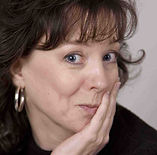How to choose the right table lamp for your room
- Julie Nolta

- Jan 6, 2018
- 4 min read

Photo: Scott Webb from Pexels
I was looking for lamps for a client’s bedroom this week and while I was busily pinning pictures on her Pinterest board and discussing options with her, it occurred to me that you might like to know the secrets to choosing the right table lamp.
You may have experienced the fact that it's pretty easy to pick the WRONG lamp: there are thousands of styles, sizes, shapes, and colors out there. So I’ve made a little list of a few things to keep in mind the next time you’re out shopping or surfing the internet.
Know your purpose before you go shopping
No, not your life's purpose, although sometimes it feels like that when you're shopping. No, it really helps to know the purpose of your LAMP because that will determine the type and size you should buy.
Do you need extra light to brighten up a dim room? Then you'll want to look for a taller, larger lamp with a wider shade and brighter bulbs to allow light to spill out farther than a short lamp would.
Photo: LampsPlus
If you need a desk lamp for doing paper work, a shorter lamp with a narrower, more opaque shade and/or a goose neck will work better to focus the light right where you need it and direct it away from your eyes.
Knowing exactly what you need before you buy it will keep you from making an annoying or expensive mistake.
Take the room’s style and colors into consideration
Naturally you’re not going to want a frilly Victorian lamp in an edgy contemporary room. However, if your decor is transitional, you’re a little more free to mix and match the style of your accessories. If your furniture is chunky, you'll want to pair it with a heavier looking lamp and a dark shade. A light and airy room might call for a lamp with a glass base and a more translucent shade.
And rather than choosing a safe and neutral color, take the opportunity to make a statement with a bold accent color you’d like to play up, or a dramatic shape. If you get tired of it or want to change your style, a lamp is so much easier to change down the road than a paint color or a sofa.

Photo: LampsPlus
You remember the client I mentioned earlier? Just for fun, here’s her bedding and artwork. Contemporary with a mix of geometrics and abstracts.

And below are a couple of the lamps we're looking at. Each of them either pull a color out of the artwork or reflect the geometric pattern in the bedding. Or both!
Lamps from West Elm and Lamps Plus
Pay attention to the lamp’s size and scale.
You don’t want a tiny lamp sitting by itself on a large table or a tall, chunky lamp dwarfing the table it’s sitting on.
Plus you need to know the table height: you don’t want to look down into a shade or up into one. An average size lamp sitting on an end table or nightstand should be somewhere between 20 and 30.”
Here’s a couple of drawings that might help you pin down a lamp size for your particular situation.
If you're sitting in a chair, the bottom of the lamp shade should be at eye level. A tape measure and some simple math will tell you what the height of the lamp base should be.

If you're sitting in bed, the bottom of the lamp shade should be at chin level.

Thanks to LampsPlus for these illustrations. So helpful
Measure your eye or chin height, subtract the height of the table, and you've got the measurement for the height of the lamp base.
I just double-checked and my bedside lamp shade is a few inches too high, but deep down I already knew that. But it can be remedied. Read on!
If you can see the neck of the lamp socket, something is wrong.
Again, the glare of a bulb isn’t pleasant, plus the socket is just ugly. If you can see it from a sitting or standing position, it usually means the lamp is too tall or the shade is too short. To solve that little problem, get a slightly longer shade or a possibly a shorter lamp harp.
The harp is the metal piece that the shade attaches to. You know, this thing:

They’re not expensive, come in a few sizes, and are easy to find at pretty much any department store that sells lamps. Not to mention Amazon which I will be perusing later.
I could go on and on about things like shade opacity, percentage of width to height, lumens, blah, blah, but we probably both need to get on with our day.
However, if you find all this fascinating, here are a few links with more information:
How to choose a lamp shade (LOTS of details and how to measure stuff!) Martha Stewart on how to choose a lamp shade
If you're in need of a new lamp, (or a new room!) and you find yourself stuck, I'm just a phone call or an email away and would love to help you!














Comments